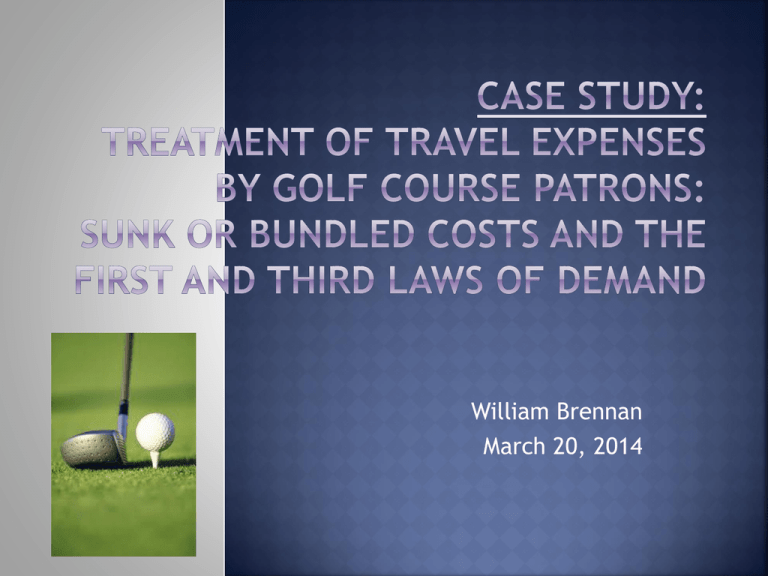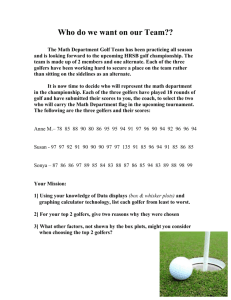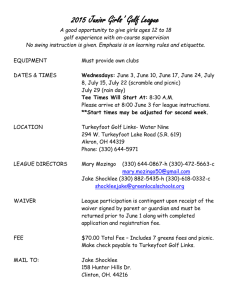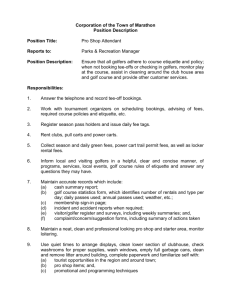Case Study: Treatment of Travel Expenses by Golf Course Patrons
advertisement

William Brennan March 20, 2014 Golfers represent an important and growing segment of the tourism market in Ohio State ranks 6th nationally in the number of private and public courses respectively (over 750 combined) In 2002: U.S.A. Ohio Ohio “Tourist” golfers * # of golfers 37M > 6M 9.3% # of rounds played 520M > 24M 12.6% $ spent on * $2.7B $321M (approx 11.9%) golfing/ related activitiesresults from the study to be discussed * represents * “tourist” = individuals living out of state and playing in Ohio or traveling over 100 miles to play within the state. Golfing = approx 8% of all recreation and attraction tourism spending in the state of Ohio. Important factors in course selection: Price Course type Style Location Number of holes Choices of residents may differ than those of tourists due to “relative price” (per Alchian-Allen Theorem): LOCALS Course A Course B TOURISTS Course A Course B Course Level Average Premium Course Level Average Premium Greens Fee $50 $100 Greens Fee $50 $100 Travel Expenses n/a n/a Travel Expenses $200 $200 $100 Total Expenses $250 $300 Price Differential 20% Preferred Course ---- Total Expenses $50 Price Differential 50% Preferred Course Course A ----- Course B Developed by Armen Alchian and William Allen in 1964 Originally referred to consumption of California grape types in California vs. New York “as a fixed cost is added to the price of two similar products, the more expensive product becomes cheaper relative to the less expensive product.” Borcherding and Silberberg – 1978 Studied consumption of Maine lobsters by residents vs. tourists Study included transportation costs of the consumer in these “fixed costs” Which of these costs are Sunk vs. Bundled? Sunk Cost A cost that has already been incurred and thus cannot be recovered. Sunk costs are independent of any event that may occur in the future. [http://www.investopedia.com/terms/s/sunkcost.asp] Bundled Cost (aka Bundling) A marketing strategy that joins products or services together in order to sell them as a single combined unit. http://www.investopedia.com/terms/b/bundling.asp “Golf consumers who bundle the entire vacation together are more likely to play the expensive golf course compared to golf consumers who separate the decisions regarding how much to pay for each of the intermediate goods and golf.” * This study acknowledges consumers can either bundle or separate travel expenses from choice of golf course, but will they ? As level of bundling increases, actual consumption of the components decreases – “true” costs of each component are masked Are golfers’ travel costs sunk or bundled ? SUNK - per Classic Consumer Theory Course A Course B Course Level Average Premium $100 Greens Fee $50 $100 $200 Travel Expenses $200 $200 Total Expenses affecting decision $250 $300 Price Differential 20% Preferred Course ---- Course A Course B Course Level Average Premium Greens Fee $50 Travel Expenses $200 Total Expenses $50 affecting decision Price Differential 50% Preferred Course Course A BUNDLED – per Alchian-Allen Theorem $100 ----- Course B Law of First Demand: Travel Sunk costs considered to be: Therefore: golfers spending more on travel expenses will spend less on golf quality Third Bundled golfers spending more on travel expenses will spend more for quality golf Higher price = higher quality (per Mullin, Hardy and Sutton - 2000) “Stratified random sample” set of 45 Ohio golf courses within 3 price points (low, middle, high*) drawn from the 5 geographic regions defined by the 2003 Ohio Golf Course Guide Data based on golfers’ responses to web-based survey Relationship between distance traveled** to play golf and the following expense variables were examined: greens fee, cart fee, total greens and cart fee, total on-course golf expenses, off-course golfrelated spending and total golf trip spending. * based on greens fees ** distance traveled represents “travel expenses” Response Rate = 56% # of responses = 376 Reliability = +/- 5% (per Zikmund – 2003) U.S.A. Ohio Ohio “Tourist” golfers * # of golfers 37M > 6M 9.3% # of rounds played 520M > 24M 12.6% $ spent on golfing/ related activities * $2.7B $321M (approx 11.9%) * represents results from this study For all golfers in the state, significant Pearson correlations (α =.01) were found between distance traveled and the various spending categories: Greens fee Greens and cart fee Total spending on the course Total trip spending For tourist golfers in the state, significant Pearson correlations (α =.01) were found between distance traveled and the following spending categories: Greens fee Greens and cart fee Total trip spending At α =.05, there were significant positive relationships found between distance traveled and the following spending categories: Cart fee Total spending on the course Supports Alchian-Allen theorem as applied to the golf industry in Ohio The relationship between distance traveled and costs is much greater when examining golf tourists only (almost absolute correlation for 4 categories): Ohio golf course managers should utilize geographic segmentation in choosing to whom to market their course, based upon their products’ price compared to area competitors, as shown by the strong, positive relationship (r=.983) found between distance traveled and cost of greens fees among Ohio golf course tourists. Price Level of Greens Fees High Suggested Target Segment Tourists from considerable distances Suggested Golf and/or travel Marketing Medium magazine advertisements Low Local Golfers Local newspaper advertisements/ similar marketing channels Suggested Product Bundled vacation Offering packages with high costs* * Being mindful of “perceived value”; e.g., offer rainy day policies. Ideal bundle structure has yet to be determined.





